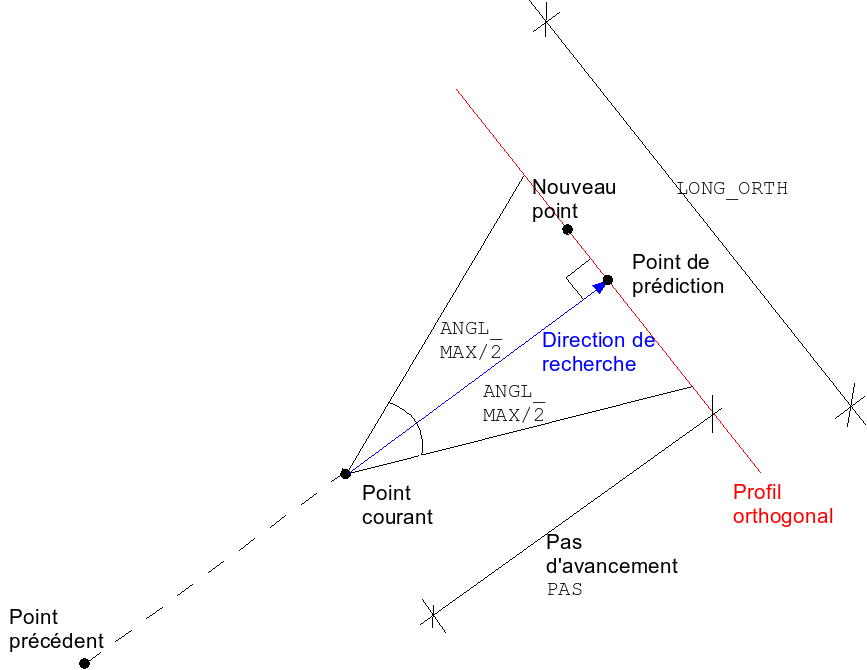3. Operands#
3.1. Operand TABLE#
♦ TABLE = CO ('table')
This operand (mandatory) allows you to give the name of the concept coming out of the command. The output table contains information on the crack path and crack opening.
If only the path is searched (option OUVERTURE =” NON “), the table has 4 columns, where for each node of the crack are displayed: the name of the crack of which the node is a part, its coordinate \(X\), its coordinate, its coordinate \(Y\), the value of the post-processed field. If the crack opening is also requested (OUVERTURE =” OUI “), it will be entered in the table in a 5th column.
3.2. Operands RESULTAT/CHAM_GD#
/♦ RESULTAT = evol_noli
♦ CHAM_GD = cham_gd
Name of the result concept containing the field to be post-processed (RESULTAT), or quantity field (CHAM_GD). It is mandatory to choose one of the two. The field to be post-processed must be a field with nodes.
3.3. Operands INST/NUME_ORDRE#
/♦ INST = inst
♦ NUME_ORDRE = order_number
These operands should only be filled in if the RESULTAT operand is present. They are used to select the moment to be post-processed. It is mandatory to choose one of the two.
3.4. Operand NOM_CHAM#
♦ NOM_CHAM = cham_name
This operand is mandatory. One gives here the name of the field to be post-treated and on which the procedure for finding cracking paths is then applied, for example VARI_NOEU.
3.5. Operand NOM_CMP#
This operand is mandatory. It allows you to choose the component to be post-processed in the field provided, for example V1. In fact, the procedure is only applicable to a scalar field.
3.6. Operand OUVERTURE#
♦ OUVERTURE =/NON /OUI
Under this operand, the type of operation performed by the command is entered. By default, we only look for the crack path (OUVERTURE =” NON). If OUVERTURE =” OUI “, the crack opening is also calculated.
3.7. Keyword RECHERCHE#
Here are the parameters for the search for cracks and corresponding openings. The call to this keyword is repeatable to allow the search for the several cracks that are located on groups of distinct cells.
3.7.1. Operands TOUT/GROUP_MA#
◊/TOUT = "OUI" [DEFAUT]
/GROUP_MA = group_ma
Under operand GROUP_MA, you can specify the group of elements on which to look for the crack path. If this operand is absent, the search is performed over the entire geometric domain defined by the mesh.
3.7.2. Operands LONG_ORTH/LONG_REG#
Under operand LONG_ORTH, we enter the length of the profile orthogonal to the search direction, used by the procedure at each calculation step. On this profile, we keep the point where the value of the field (projected and smoothed) is maximum, which gives the new point of the crack path. LONG_ORTH should normally be equal to or greater than the width of the damaged band. The projection of the field onto this profile is smoothed using another length, LONG_REG, to avoid the new point being on the edge of a finite element. For the correct functioning of the method, LONG_REG must be in the range \(0.5\) to \(2\) times the size of the meshes that are in the damaged band. A diagram of the search for the crack path is shown; we will look at document [R7.02.17] for a more detailed explanation of how the control works.

Figure 3.7.2-a : diagram of the search for the crack path.
3.7.3. Operand PAS#
♦ PAS = not
This is a step forward in the research procedure. There is no recommended value, the procedure is quite robust in relation to the choice of this parameter. On the other hand, if the progress step is too great, there is a risk of not detecting the portions of the crack characterized by strong curvatures. A small step (of the order of magnitude of the size of the finite element) may be recommended if you want to have a lot of points to discretize the crack.
3.7.4. Operand BORNE_MIN#
◊ BORNE_MIN = threshold
Value of the field in correspondence with which the search for the path of the crack is stopped.
3.7.5. Operand BORNE_MAX#
♦ BORNE_MAX = lfpz
This quantity defines the width of the damaged band, over which the crack opening is calculated. It should only be filled in with the option OUVERTURE =” OUI “.
3.7.6. Operand ANGL_MAX#
◊ ANGL_MAX =/120.
/max_angle
The search on the orthogonal profile can be restricted to a central piece defined by an angle (in degrees) equal to angle_max, symmetric with respect to the prediction point (see the).
3.7.7. Operand NB_POINTS#
◊ NB_POINT = nb_points
This keyword allows you to define the number of points on half of the orthogonal profile, which defines the precision on this one. By default, this parameter is equal to 500.